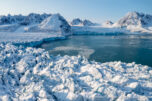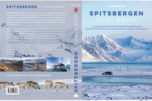-
current
recommendations- Liefdefjord
New page dedicated to one of Spitsbergen's most beautiful fjords. Background information and many photos.
- New Spitsbergen guidebook
The new edition of my Spitsbergen guidebook is out and available now!
- Liefdefjord
New page dedicated to one of Spitsbergen's most beautiful fjords. Background information and many photos.
Page Structure
-
Spitsbergen-News
- Select Month
- May 2025
- April 2025
- March 2025
- February 2025
- January 2025
- December 2024
- November 2024
- October 2024
- September 2024
- August 2024
- July 2024
- June 2024
- May 2024
- April 2024
- March 2024
- February 2024
- January 2024
- December 2023
- November 2023
- October 2023
- September 2023
- August 2023
- July 2023
- June 2023
- May 2023
- April 2023
- March 2023
- February 2023
- January 2023
- December 2022
- November 2022
- October 2022
- September 2022
- August 2022
- July 2022
- June 2022
- May 2022
- April 2022
- March 2022
- February 2022
- January 2022
- December 2021
- November 2021
- October 2021
- September 2021
- August 2021
- July 2021
- June 2021
- May 2021
- April 2021
- March 2021
- February 2021
- January 2021
- December 2020
- November 2020
- October 2020
- September 2020
- August 2020
- July 2020
- June 2020
- May 2020
- April 2020
- March 2020
- February 2020
- January 2020
- December 2019
- November 2019
- October 2019
- September 2019
- August 2019
- July 2019
- June 2019
- May 2019
- April 2019
- March 2019
- February 2019
- January 2019
- December 2018
- November 2018
- October 2018
- September 2018
- August 2018
- July 2018
- June 2018
- May 2018
- April 2018
- March 2018
- February 2018
- January 2018
- December 2017
- November 2017
- October 2017
- September 2017
- August 2017
- July 2017
- June 2017
- May 2017
- April 2017
- March 2017
- February 2017
- January 2017
- December 2016
- November 2016
- October 2016
- September 2016
- August 2016
- July 2016
- June 2016
- May 2016
- April 2016
- March 2016
- February 2016
- January 2016
- December 2015
- November 2015
- October 2015
- September 2015
- August 2015
- July 2015
- June 2015
- May 2015
- April 2015
- March 2015
- February 2015
- January 2015
- December 2014
- November 2014
- October 2014
- September 2014
- August 2014
- July 2014
- June 2014
- May 2014
- April 2014
- March 2014
- February 2014
- January 2014
- December 2013
- November 2013
- October 2013
- September 2013
- August 2013
- July 2013
- June 2013
- May 2013
- April 2013
- March 2013
- February 2013
- January 2013
- December 2012
- November 2012
- October 2012
- September 2012
- August 2012
- July 2012
- June 2012
- May 2012
- April 2012
- March 2012
- February 2012
- January 2012
- December 2011
- November 2011
- October 2011
- September 2011
- August 2011
- May 2011
- April 2011
- March 2011
- February 2011
- January 2011
- December 2010
- November 2010
- September 2010
- August 2010
- July 2010
- June 2010
- May 2010
- April 2010
- March 2010
- February 2010
- November 2009
- October 2009
- August 2009
- July 2009
- June 2009
- May 2009
- April 2009
- March 2009
- February 2009
- January 2009
- December 2008
- November 2008
- October 2008
- August 2008
- July 2008
- June 2008
- May 2008
- April 2008
- March 2008
- February 2008
- April 2000
- Select Month
-
weather information
-
Newsletter

| Guidebook: Spitsbergen-Svalbard |
Home →
Yearly Archives: 2018 − News & Stories
Kvitøya – 19 July 2018
Thu
19 Jul
2018
We ventured out to the remotest parts of Spitsbergen, the island of Kvitøya in the northeast of the Svalbard archipelago, not far from Russian Franz Josef Land. This is where Salomon August Andrée, Knut Frænkel and Nils Strindberg reached land for the first time again after a balloon flight of 3 days and more than 2 months of marching across the drifting ice. They started to get ready for the winter, but died all after a short time for reasons which we will never really find out for sure.
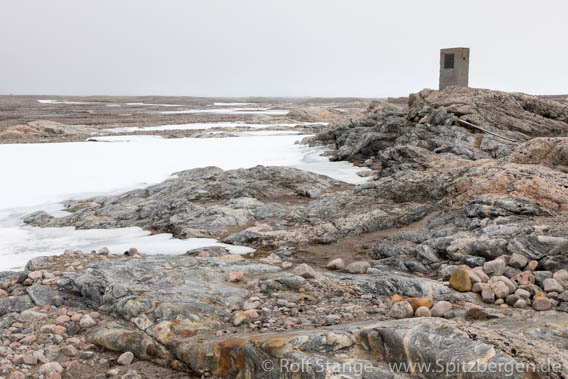
It needs a lot of luck to get to this place. Even today, Kvitøya is often surrounded by ice, and when this is not the case, then the surf is often going high on the exposed coast. And when this is not the case, then there are often some polar bears hanging around. The way from the shore to the place where Andrée, Frænkel and Strindberg had their final camp is short, but not easy to walk.
Today, we are lucky! It is a bit foggy, which fits the atmosphere of this desolate place perfectly well.
Duvefjord – 18 July 2018
Wed
18 Jul
2018
A beautiful day in a beautiful area at the end of the world, in a little bay in the remote northeast of the remote Nordaustland. Seemingly empty polar desert, full of colours and structures.

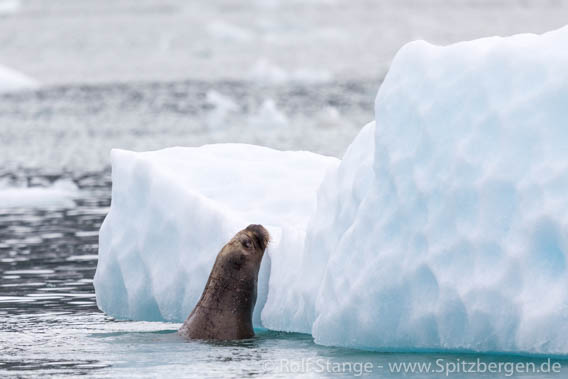
After some hours of sailing in unknown waters near rocky islands, we reach a bay with a huge glacier and many icebergs. Walrusses are in the water every here and there, and then we discover three polar bears who are crossing the fjord. A mother and two first-year cubs. They swim between the icebergs before they climb up the steep slope.

Sjuøyane – 17 July 2018
Tue
17 Jul
2018
The weather is really on our side! The first thing is a pretty rare landing on Waldenøya, a small and remote island, in a mirror-like sea today. Definitely a place that does not see a lot of visitors! Walter Wellman was stranded here for a couple of weeks with his expedition in 1894. We sit on the rocks and enjoy the sun and the undisturbed view to the north pole.
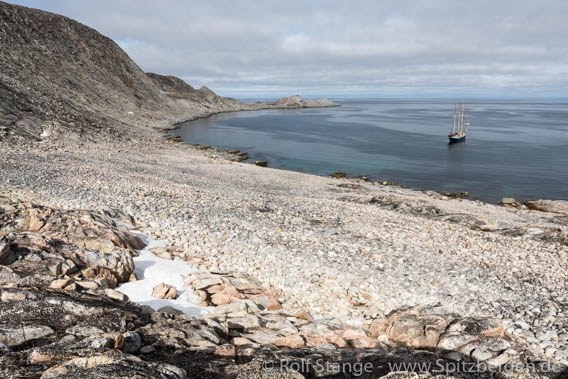
It is sunny and calm all the way up to Rossøya, so we enjoy a Zodiac cruise around this islet, Svalbard’s very northernmost one. Further north, there is just water, liquid and solid, and the north pole. A rare sunny day in these latitudes!
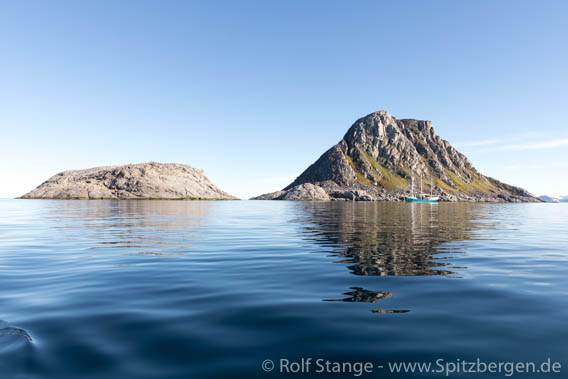
An evening excursion to Phippsøya does not yield walrusses, as we had been hoping for, but a polar bear. Which showed up on a pretty short notice as we had just gone ashore. Alex, who was scouting the terrain, had the pleasure to discover the bear, which had been sleeping in a terrain depression, at a rather uncomfortable distance, but it was not at all interested in us and turned its attention to a rather rotten carcass of a walrus. We went back into the boats and enjoyed the views in safety for man and beast. A great day on 80 degrees north!
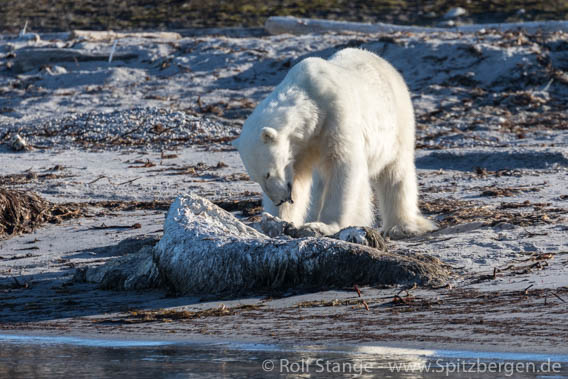
Kongsfjord & Antigua under sail – 14 July 2018
Tue
17 Jul
2018
A calm night at anchor, great! Hiking over Blomstrandhalvøya is at least as great. The coastal scenery is really varied and interesting, especially if you know some of the hidden places beyond Ny London.

Then we set course to the north. The wind is a bit less than expected, but enough to fill the canvas, so we enjoy a silent crossing under sail and a sky the colours of which are changing back and forth between grey, silver and even blue in places.
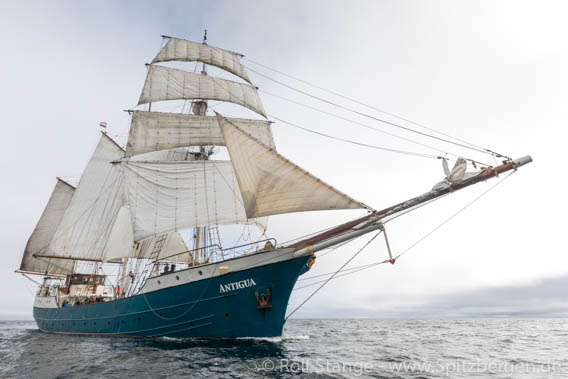
Bockfjord – 16 July 2018
Mon
16 Jul
2018
It is great to be out for a full, long day in Spitsbergen’s beautiful nature. And the warm springs far inland in Bockfjord are fascinating. A great destination for a long hike! We spend hours getting there, hiking across tundra with plenty of flowers and a river plain that looks like kind of a wadden sea. After an extended rest with some food, we have soon reached the fields with the sinter terraces. Nature has indeed created some very impressive pieces of art here! All this comes with a stunning background: a mighty wall of dark-red mountains, some huge moraines and rugged mountains.
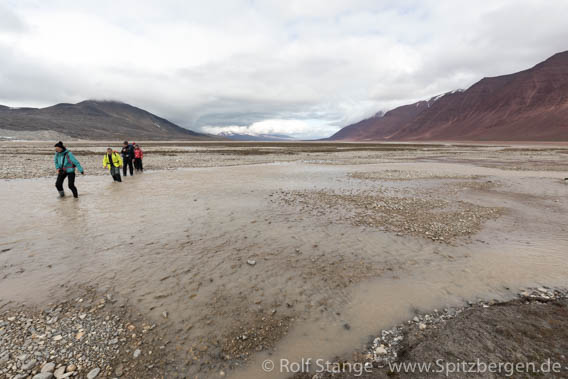
We enjoy the scenery, the weather, the hike and life in general for a full day. It is a timeless place. We are back on board after 9 hours.
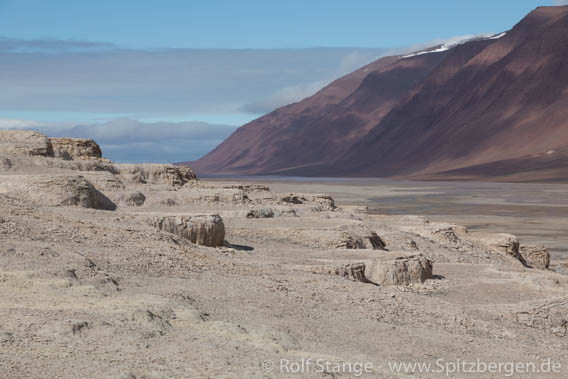
Of course there was also the option for walks within a „normal“ scale. There are also warm springs close to the shore, and another walk went to a nearby glacier.
The weather forecast is promising for the far north, so we set course northeast in the evening.
A week on Antigua and taking off again with SVA Antigua – 12 July 2018
Sun
15 Jul
2018
Time is just flying in the summer arctic. Nothing too amazing going on in Longyearbyen. Somebody managed to park a car in a pond next to the road in Adventdalen. One is tempted to ask: why? I don’t know. Nobody was hurt, at least. Some tourists thought that huts in the wilderness are principally open for everybody. This is not the case. It took the police to get this message across in this given case. It also took the police to convince two female tourists that you have to leave the boat when the trip was over even if it did not meet your expectation. People in Longyearbyen don’t know if they should laugh or cry sometimes. In yet another case, the police found vertebra of marine mammals in some tourist’s luggage at the airport. Not good. One day, when MSC Meraglivivia was in the harbour, the number of peole in Longyearbyen tripled.
Make sure you don’t end up on the wrong ship!
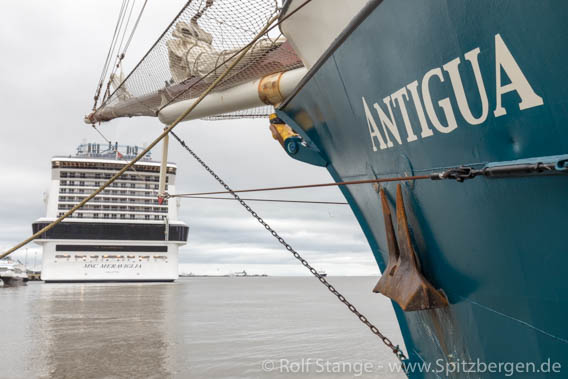
Soon we will take off with SV Antigua. Time to check a huge pile of equipment, sort stuff, repair some items, replace other ones. So time is flying as usual, and suddenly Antigua is in the harbour. An immense pile of equipment needs to be carried on board and then it is already time for take-off. Welcome on board and here we go! We are steaming against a breeze out of Isfjord and then turn into Forlandsund. Spitsbergen, here we come!
Woodfjord – 15 July 2018
Sun
15 Jul
2018
Gråhuken! We are not far from this famous cape as we wake up. A light breeze is blowing from the northwest, but not too much, it is not a problem to land and we are happy to pay a visit to the famous hut where Christiane Ritter wintered in 1934-35 (she immortalized her adventure in the book „A woman in the polar night“). I have got a very special reason to be happy to get to this hut now, and today’s visit is indeed humbling and touching. More about that later.
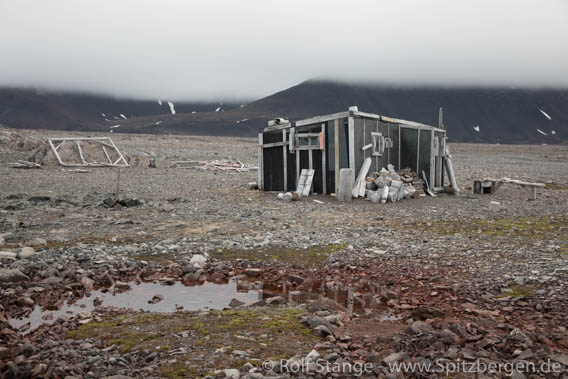
In a later stage of today’s landing at Gråhuken, a polar bear turns up. It is a safe distance, and he (or she) turns around and moves away as soon as he (or she) gets aware of us. So do we.

An excursion to one of the small islands in Liefdefjord turns out to be a visit to an arctic paradise. Colours, structures, birds. Plenty of them.
Kongsfjord & Antigua unter Segeln – 14. Juli 2018
Sat
14 Jul
2018
Eine ruhige Nacht vor Anker, herrlich! Mindestens so herrlich war die Tour auf der Blomstrandhalvøya. Die Küstenlandschaft ist sehr abwechslungsreich, vor allem, wenn man ein paar bestimmte Ecken kennt. Es gibt nicht nur Ny London, sondern noch so ein paar richtig schöne, versteckte Stellen.
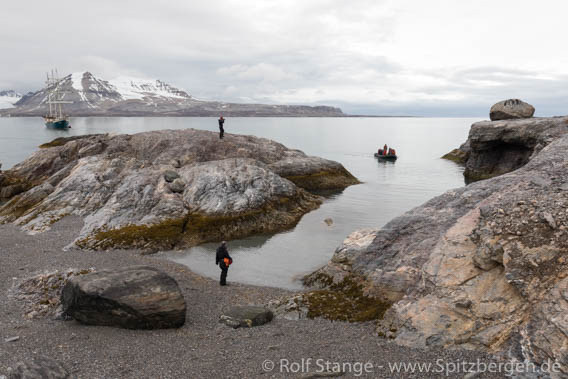
Dann setzen wir Kurs Nord. Der Wind pustet zwar nicht ganz so fröhlich wie erwartet, aber immer noch fröhlich genug, um die Tücher zu füllen, und so genießen wir die Stille unter Segeln und einem Himmel, dessen Farben zwischen Grau, Silber und punktuellem Blau oszillieren.

Kongsfjord & Krossfjord – 13 July 2018
Fri
13 Jul
2018
Our first day out and away from Longyearbyen! Our first stop is Ny-Ålesund in Kongsfjord, a gradual transition from civilisation to wilderness. The village is calm today, goose families are feeding on the tundra between the houses. While we walk around, Alex gives a talk about the past and presence of Ny-Ålesund, I give a talk about Roald Amundsen and all the north pole expeditions through the centuries and as we happen to meet Marten Loonen, leader of the Dutch Arctic Station, we even get the latest news about Barnacle geese, Common eider ducks and their rather unrelaxed relationship to polar bears that look for food on the breeding islands of these birds in Kongsfjord.

We sail up Krossfjord in the afternoon, land at Camp Zoë, an old Rudi-/Mansfield-hut and do various walks and hikes in the tundra and up the hills. The surrounding mountains are very impressive. We share the tundra with reindeer, ptarmigan and a lonely polar fox and enjoy the view of some white horses on the blue water of Krossfjord.

An evening visit to Tinayrebreen is the icing on the cake on this day, a Friday the 13th. It is Anke’s and Christiane Ritter’s birthday today. Happy birthday!
Landslide in Longyearbyen: road open again for pedestrians and bicyclists
Way 300 in Longyearbyen was closed for all traffic after a landslide close to the cemetary. This road connects Skjæringa (the part of Longyearbyen where church, Sysselmannen etc. are located) and Huset.
The Sysselmannen has now opened Way 300 again for pedestrians and bicyclists. Motorised traffic is not permitted. This is valid until further notice from the Sysselmannen.
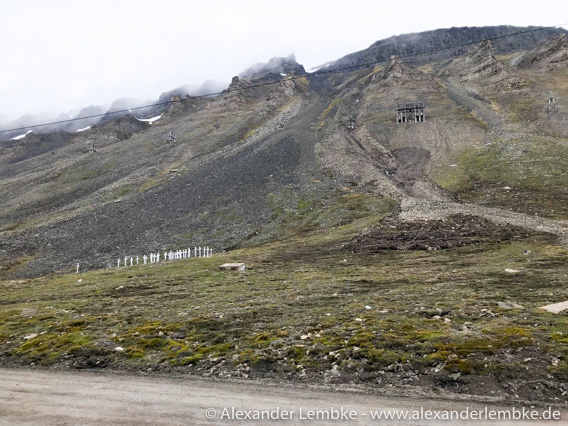
Landslide in Longyearbyen near the cemetery: now way 300 is open again for non-motorised traffic. Image © Alexander Lembke.
Hurtigruten bans disposable plastic
On July 2, the traditional shipping company Hurtigruten celebrates its 125th birthday and at the same time gives a present to the environment: From today on Hurtigruten wants to banish all disposable plastic from its ships. No plastic straws, no stirrers in plastic coffee cups, no plastic lids and not a single plastic bag should then be found on the ships.
This is only logical: ship travellers witness the pollution of the oceans with plastic waste every day. Most of the plastic in the oceans comes from fishing, but plastic bottles, plastic bags or other everyday plastic articles also end up on Norway’s beaches by the ton and too often end up in the stomachs of seabirds, fish and whales.
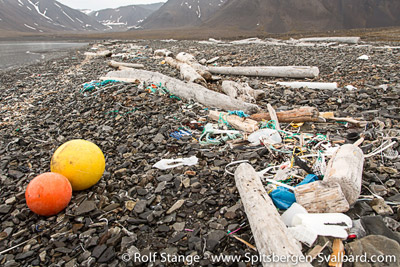
Plastic waste in Mushamna/ Spitsbergen
The ban on disposable plastic articles will be effective across the entire Hurtigruten fleet, i.e. both on the legendary postal ship route from Bergen to Kirkenes, as well as on cruise ships in polar waters and in all land-based facilities and also on Spitsbergen.
Hurtigruten’s ambitious long-term goal is even to become the first plastic-free shipping company in the world. Even if there is certainly still much room for improvement in the cruise ship industry in terms of pollution and CO2 emissions, the ban on disposable plastic is a welcome step in the right direction.
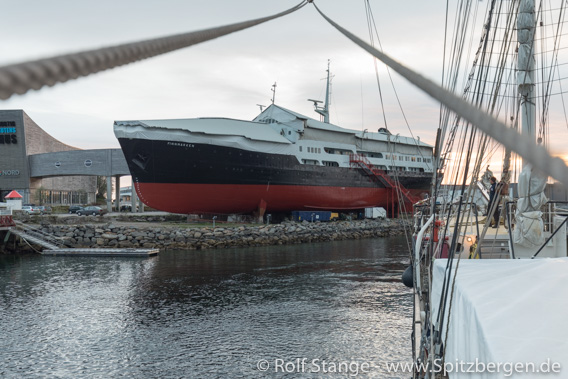
Soon free from diposable plastic: Hurtigruten museumsship in Stokmarksnes
Source: Hurtigruten
Landslide in Longyearbyen: road closed
A landslide from Platåberget crossed the road near the cemetery in Longyearbyen a few days ago. Nobody was injured and the event was not seen by anyone, as far as known, but the road from the old museum to Huset has been closed by the Sysselmannen for safety reasons until further notice.
It is not the first landslide in this area. Previous events had triggered a debate to move the cemetery to a safer location near the church to prevent it from possible damage, but no decisions have been made so far.
Smaller landslides as the recent one are generally a common and well-known phenomenon on slopes like the one near the cemetery. They may occur anywhere on similar slopes in the field, especially in the early summer, after the snow melting period. Landslides of this type are normally not too fast, so hikers should be able to move away and into safe territory without difficulties. But the danger potential has to be considered for example when putting up a tent, and there are other types of landslides and mudflows that involve more water and higher velocities. In June 1992, a scientist was killed by a torrential slush avalanche in Liefdefjord.
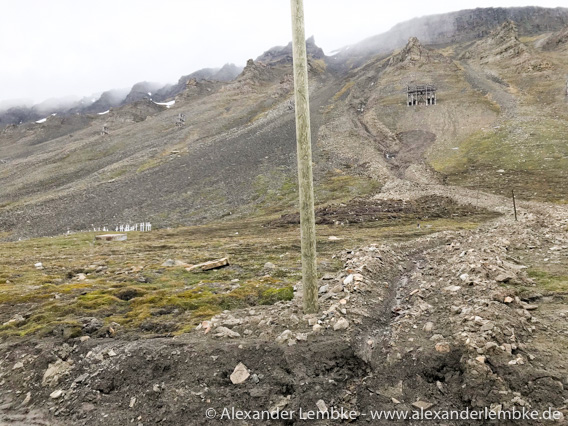
Landslide in Longyearbyen near the cemetery. Image © Alexander Lembke.
Patagonia under sail 2018: triplog and fotos
Following to the triplog and photos of our Antarctic expedition with SY Anne-Margaretha in early 2018, we have now got the Patagonia triplog with associated photo collections and some short storytelling online. With the log, stories and photos, you can join us retrospectively at no cost and enjoy Patagonia’s wonderfully wild landscapes and waterways with no “risk” of wind and waves, seasickness and cold – have fun!
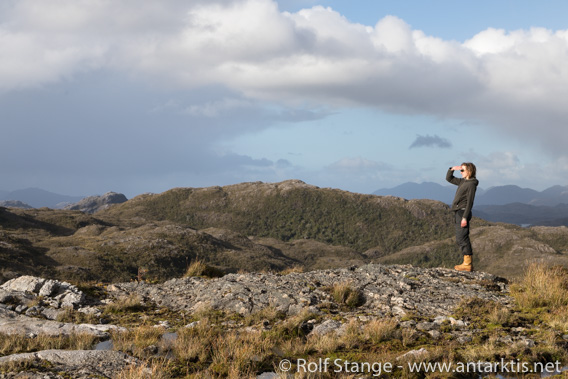
Hiking on one of Patagonia’s many remote islands.
And yes, we are fairly confident that this Patagonia adventure was not the last one of its kind, there is still so much to discover! We have no dates fixed yet, and it won’t happen as early as the next austral season (2018/19), but we’ll return to Patagonia, no doubt!
But first, I’ll soon return to Spitsbergen! So my arctic travel blog will get new stuff regularly from July onwards.
Polar bear observed close to Longyearbyen
Less than a week after the polar bear visit to Kapp Linné, which made it big in international media, another polar bear was seen near a settlement in Spitsbergen. This time, it was Longyearbyen, the main settlement.
The bear was seen for the first time Friday evening in Adventdalen close to the old airstrip, some kilometres southeast of Longyearbyen, walking to the settlement.
Soon, the Sysselmannen was on site with the helicopter, the polar bear had already come quite close to town. Scared away by the helicopter, the bear moved to Hiorthhamn, opposite of Longyearbyen. Later, when the bear was seen swimming in Adventfjorden, a group having a party with a fire on the beach in Longyearbyen was evacuated – a safety measure without any drama, the bear was not seen anywhere near the site.
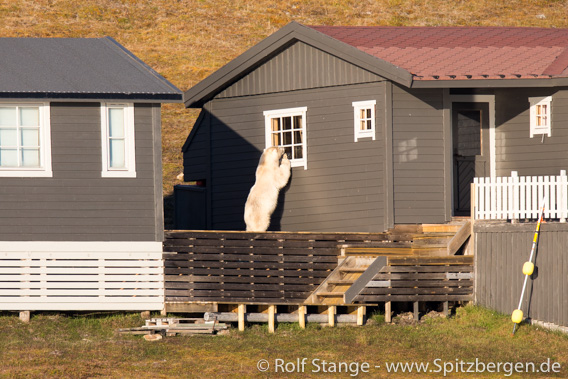
Polar bear in Adventfjord, not far from Longyearbyen (archive image, 2014).
The polar bear was seen for the last time Saturday around noon on the way into Sassenfjord. Since then, its whereabouts are not know, and the authorities have closed the “case” until further observations may be made and reported by anyone in the field.
It is said that the bear was a large male. There were no situations dangerous for humans or the bear.
The case shows how important it is to be alert and prepared also in the area close to Longyearbyen.
Spitsbergen under sail with SV Antigua in July 2018: double cabin available
18 intense days in Spitsbergen on SV Antigua, a 3 mast sailing ship – a dream voyage for arctic enthusiasts! Now there is the chance to join us on our voyage in July (12-29, 2018). Fully booked since long ago, two beds in a double cabin are now available again after a cancellation.
This trip will be German speaking … you don’t have to be able to write poems in German, but if you have basic knowledge good enough for everyday communication, then – welcome!
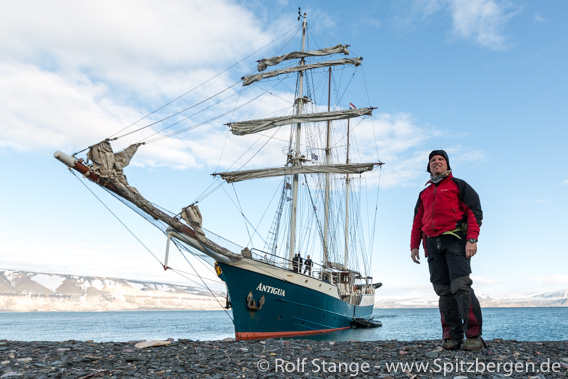
Spitsbergen under sail with Antigua in July 2018: two beds in double cabin available.
So – get in touch an welcome on board! Click here for more information about this voyage.
Please don’t hesitate to contact Rolf Stange for any questions about the itinerary, the ship, Spitsbergen, equipment etc. or the Geographische Reisegesellschaft (Geographical travelling society) for reservations and booking.
News-Listing live generated at 2025/May/03 at 14:39:55 Uhr (GMT+1)
